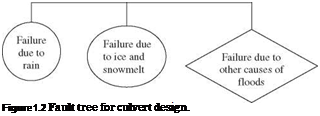Reliability of Hydrosystem Engineering Infrastructure
The performance of a hydrosystem engineering infrastructure, function of an engineering project, or completion of an operation all involve a number of contributing components, and most of them, if not all, are subject to various types of uncertainty (Fig. 1.1). Detailed elaboration of uncertainties in hydrosystem engineering and their analysis are given in Tung and Yen (2005). Reliability and risk, on the other hand, generally are associated with the system as a whole. Thus methods to account for the component uncertainties and to combine them are required to yield the system reliability. Such methods usually involve the use of a logic tree, which is discussed in Chap. 5. A typical logic tree for culvert design is shown in Fig. 1.2 as an example.
The reliability of an engineering system may be considered casually, such as through the use of a subjectively decided factor of safety (see Sec. 1.6). Today, reliability also may be handled in a more comprehensive and systematic manner through the aid of probability theory. Factors that contribute to the slow development and application of analyses of uncertainty and reliability in hydrosystem engineering infrastructure design and analysis include the following:
1. Those who understand the engineering processes well often are not trained adequately and are uncomfortable with probability. Contrarily, those who are good in probability theory and statistics seldom have sufficient knowledge of the details of the engineering process involved.
|
|||||||||||||
|
|||||||||||||
Construction Procedure Deterioration Maintenance & manufacturing or process і
|
Inspection |
Repair |
||||
|
Formulation |
Parameter |
Execution |
Numerical |
|
Measurement |
Inadequate |
Handling and |
Statistical |
|
|
error |
sampling |
transcription |
analysis |
|
|
error |
of data |
|||
![]()
 |
Sources of uncertainty. (After Tung and Yen, 2005.)
|
|
|
![]()



OR
2. Many factors contribute to the reliability of an engineering system. Only recently have advances in techniques and computers rendered the combination and integration of these contributions feasible to evaluate the system reliability. Nevertheless, some of the factors are still beyond the firm grasp of engineers and statisticians. Furthermore, these factors usually require the work of experts in different disciplines, whereas interdisciplinary communication and cooperation often are a problem.
3. Engineers have a tendency to focus on components affecting their problem most while ignoring other contributing elements. For instance, hydrologists as a group perhaps have contributed more than any other discipline to frequency analysis and also have made major contributions to related probability distributions. Yet their devotion and accomplishment are a blessing as well as a curse, in that they hinder the vision to see beyond to a broader view of uncertainty and reliability analyses. As noted by Cornell (1972):
It is important to engineering applications that we avoid the tendency to model only those probabilistic aspects that we think we know how to analyze. It is far better to have an approximate model of the whole problem than an exact model of only a portion of it.
Only more recently, uncertainties other than natural randomness of floods/ rainfalls are considered in reliability-based design of flood mitigation schemes (U. S. National Research Council, 2000).
4. Inconsistent definitions of risk and risk analysis cause considerable confusion and doubt about the subject. For example, in flood protection engineering, hydraulic engineers tend to accept the definition used by structural, aerospace, and electronic engineers that risk analysis is the analysis of the probability of failure to achieve the intended objectives. Hydrologists often consider risk in terms of the return period, which is considered as the reciprocal of the annual exceedance probability of the hydrologic events (i. e., flood, storm, or drought). Water resources planners and decision makers mostly adopt the definition used in economics and the health science fields, regarding risk analysis as the analysis of risk costs, assessment of the economic and social consequence of a failure, and risk management. For example, the United Nations Department of Humanitarian Affairs (1992) defines risk as
The expected losses (of lives, persons injured, property damaged and economic activity disrupted) due to a particular hazard for a given area and reference period. Based on mathematical calculations, risk is the product of hazard and vulnerability.
Further, hazard is defined as “a threatening event or the probability of occurrence of a potentially damaging phenomenon within a given time period and area.” Hence, in the United Nations terminology, hazard is what engineers define as risk. The problem of confusion probably would be minimized if the experts in these subdisciplines worked separately, each responsible for his or her own specialty. However, the trend of the past decades, expecting jack-of-all-trades water resources engineers to be experts in all these subdisciplines, bears significant undesirable consequences, a small one ofwhich is the confusion concerning the definition of risk.
Practically all hydrosystem engineering infrastructures placed in a natural environment are subject to various external stresses and loads. The resistance, strength, capacity, or supply of the system is its ability to accomplish the intended mission satisfactorily without failure when subjected to demands or external stresses. Loads, stresses, and demands tend to cause failure of the system. Failure occurs when the demand exceeds the supply or the load exceeds the resistance. Owing to the existence of uncertainties, the capacity of an infrastructural system and the imposed loads more often than not are random and subject to some degrees of uncertainty. Hence the design and operation of engineering systems are always subject to uncertainties and potential failures.
Nevertheless, engineers always face the dilemma of decision making or design with imperfect information. It is the engineer’s responsibility to obtain a solution with limited information, guided by experience and judgment, considering the uncertainties and probable ranges of variability of the pertinent factors, as well as economic, social, and environmental implications, and assessing a reasonable level of safety.






Leave a reply